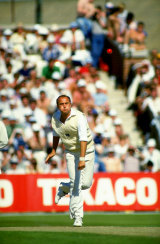From rucks to riches
The Middlesex and England spinner was a one-off, a revel with a Rolls-Royce and a talent for making trouble and money that appealed to Nick Greenslade
|
|

|
The first time I heard Phil Edmonds speak he was, fittingly, talking about money. It was the high-water mark of Thatcherism in the late 1980s and he was asked about attitudes to wealth on either side of the Atlantic. "If someone in the United States sees a guy driving a Rolls-Royce, he'll say to himself, `Good on him,'" Edmonds observed. "In Britain people just look on enviously and want to knock you."
Edmonds was not the first or last English plutocrat to make this unfavourable comparison but it was not the kind of comment one expected from an England cricketer. I had suspected there was something different about the Middlesex spinner since I first came across him in 1982. Recalled for England's home series against India after an exile of three years, he came with talk of "an unsettling influence".
The more I saw, the more intrigued I became. When he took the field it was with a Swatch on his wrist: alone among the England team Edmonds had negotiated a sponsorship deal with a watch brand. Asked to field around the bat, he would encroach ever closer, allowing his shadow to fall across the business part of the pitch. Invariably he had a choice word for the batsman. Chat, like wealth, was not something Edmonds lacked. Yet he also had talent. On England debut, against Australia in 1975, he took 5 for 28 with his left-arm spinners. It was a remarkable introduction to Test cricket. His success stemmed from height and strength, which brought considerable turn and flight, as well as bounce. This last ingredient was apparent when he occasionally threw in a bouncer, upsetting his own unsuspecting keeper as much as the batsman.
Though never an allrounder, Edmonds was a useful lowerorder bat. In that summer of 1982 he and Derek Randall - an odd couple, to be sure - rescued England from a middle-order collapse and set up a decisive win in the first Test. Edmonds hit 64. A Test average of 17, however, indicates that he did not fulfil his potential. A blasé approach to dismissal did not help. As his county team-mate Simon Hughes has written, Edmonds would often walk back to the pavilion "chuckling with a mixture of mild disbelief and perverse pleasure".
For captains this must have been infuriating. For me it completed the picture of a loveable maverick. The son of a colonial property developer in northern Rhodesia, a Cambridge graduate and a man as comfortable in the boardroom as dressing room, he looked ideal establishment material. But he was much more a son of Africa than of Empire; he was involved in the black independence movement in the late 1960s.
His anti-establishment credentials were confirmed by his continual disagreements with authority, particularly Mike Brearley. The England and Middlesex captain was the last person he should have been upsetting but Edmonds was his own man. After a spat too many he pinned Brearley to the wall and warned him to "lay off". Later I heard he had treated his biographer Simon Barnes in the same manner.
Despite their differences, Brearley, as fine a judge as any, rated Edmonds. In The Art of Captaincy he writes that he appreciated his spinner's shrewd cricketing brain. Brearley put him in the same awkward-but intelligent category as Geoff Boycott and it is perhaps not surprising that this abrasive pair struck up a friendship. Boycott called them the `Fitzwilliam twins' - Fitzwilliam being his home town in Yorkshire and Edmonds' Cambridge college. Edmonds' cardinal sin, however, was to marry a woman of independent means and mind. During the 1980s England cricketers were not expected to bring their wives on tour, never mind have them write about the experience. Shortly after publishing Another Bloody Tour, her best-selling account of the disastrous trip to the Caribbean in 1985-86, Frances Edmonds was probably known to more people than her husband, a point not lost on Tim Zoehrer. "At least I have an identity," the Australian keeper said in response to the usual sledging. "You're only Frances Edmonds' husband." The result of his idiosyncrasies was that he missed more Tests (75) than he played (51). His most successful period came when he played under a captain, David Gower, who was equally laidback.
On Gower's 1984-85 trip to India, the last England victory in that country, Edmonds and his fellow spinner Pat Pocock bowled long spells to tie up the batsmen. The following summer he was an integral member of the team that won back the Ashes from Allan Border's Australia, and he was no less important on the victorious trip to defend them in 1986-87. After that, business began to get in the way of the day job and in 1987 Edmonds retired from fi rst-class cricket. However, another improbable comeback remained. In 1992, aged 41 and pepped up by an industrial supply of painkillers - there was talk of him being shielded from the drug testers - he defi ed his ailing back, arrived at Trent Bridge (in a Rolls-Royce, naturally) and took 4 for 48 for an injury-struck Middlesex.
Today he is chairman of the county but no less controversial. His recent business dealings in war-torn Sudan have raised eyebrows among the blazer brigade as his wining and dining of commercial associates during luncheon intervals once did. I do not suppose for a moment that he gave a damn and I would be disappointed if he did.
This article was first published in the June issue of The Wisden Cricketer.
Click here for further details.
Nick Greenslade is assistant editor of Observer Sport Monthly
